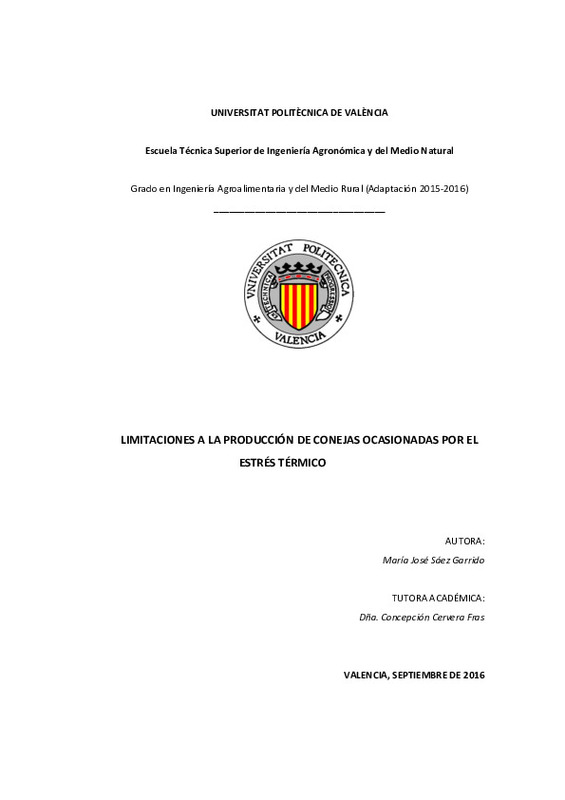JavaScript is disabled for your browser. Some features of this site may not work without it.
Buscar en RiuNet
Listar
Mi cuenta
Estadísticas
Ayuda RiuNet
Admin. UPV
Limitaciones a la producción de conejas ocasionadas por el estrés térmico
Mostrar el registro sencillo del ítem
Ficheros en el ítem
| dc.contributor.advisor | Cervera Fras, Mª Concepción
|
es_ES |
| dc.contributor.author | Sáez Garrido, María José
|
es_ES |
| dc.date.accessioned | 2016-09-09T14:05:04Z | |
| dc.date.available | 2016-09-09T14:05:04Z | |
| dc.date.created | 2016-09-08 | |
| dc.date.issued | 2016-09-09 | es_ES |
| dc.identifier.uri | http://hdl.handle.net/10251/69220 | |
| dc.description.abstract | [ES] La producción de las conejas lactantes puede verse limitada cuando se encuentran en temperaturas altas o en distintos estados fisiológicos. El presente proyecto se llevó a cabo con el objetivo de averiguar cómo afecta a la producción de las conejas en lactación sometidas a estrés térmico cuando se encuentran en primer o segundo parto. Se emplearon 63 conejas que se encontraban en primero (34 animales) y segundo parto (29 animales) y que fueron alojadas en una cámara climática con temperatura ambiental superior a los 28°C (32 conejas) y las otras 31 se alojaron en una nave convencional de maternidad con temperaturas medias diarias entre 13 y 20°C. Se midió la producción de leche, el peso vivo y la evolución del grosor de depósitos grasos de la coneja desde el parto hasta los 14 días de lactación y la evolución del peso de los gazapos lactantes hasta el destete. Se realizaron ensayos de digestibilidad in vivo de todas las conejas entre los días 14 y 18 de lactación y se calcularon sus coeficientes de digestibilidad aparente de materia seca, materia orgánica, energía bruta, proteína bruta, fibra neutro detergente y fibra ácido detergente. Las conejas alojadas en la cámara climática presentaron mayores coeficientes de digestibilidad aparente de todos los nutrientes estudiados (66% frente a 62% para la materia seca en cámara y nave, respectivamente) debido a una reducción de la ingestión de un 35%, mientras que el número de parto no parece afectar a la utilización digestiva del alimento. A pesar de ello, la menor ingestión de las conejas alojadas en condiciones de estrés térmico reduce la disponibilidad de energía digestible y de proteína digestible frente a las conejas alojadas en la nave y limita el incremento de peso (13 vs. 20 g/día) y la producción de leche de la coneja (209 vs. 258 g/día), limitando por tanto el crecimiento de los gazapos lactantes (13 vs. 15 g/día). | es_ES |
| dc.description.abstract | [EN] The lactating rabbits production may be limited when they are at high temperatures or in different physiological states. This research was carried out with the aim to find out how it affects production by lactating female rabbits subjected to heat stress when they are in first or second parturition. 63 rabbits in first (34) and second parturition (29) were used, 32 animals were housed in a climate chamber with more than 28°C ambient temperature and the other 31 were housed in a conventional ship motherhood with average daily temperatures between 13 and 20°C. The milk production, body weight and evolution of the thickness of fatty deposits rabbit does from birth to 14 days of lactation and weight development of infants until weaning rabbits were measured. Digestibility trial were performed in vivo of all rabbits between 14 and 18 of lactation and their coefficients of apparent digestibility of dry matter, organic matter, crude energy, crude protein, neutral detergent fiber and acid detergent fiber were calculated. The rabbits housed in the climatic chamber showed higher coefficients of apparent digestibility of all nutrients studied (66% versus 62% for dry matter in climate chamber and conventional ship, respectively) due to reduced intake by 35%, while the number of parturition does not appear to affect the digestive use of food. However, the lower intake of rabbits housed in heat stress conditions reduces the availability of digestible energy and protein and limits the weight gain (13 vs. 20 g/day) and the milk production od rabbit does (209 vs. 258 g/day), thereby limiting the growth of kits (13 vs. 15 g/day). | es_ES |
| dc.format.extent | 45 | es_ES |
| dc.language | Español | es_ES |
| dc.publisher | Universitat Politècnica de València | es_ES |
| dc.rights | Reserva de todos los derechos | es_ES |
| dc.subject | Conejas | es_ES |
| dc.subject | Estrés por calor | es_ES |
| dc.subject | Digestibilidad | es_ES |
| dc.subject | Ciclos reproductivos | es_ES |
| dc.subject | Producción de leche | es_ES |
| dc.subject | Grasa perirrenal | es_ES |
| dc.subject | Rabbit does | es_ES |
| dc.subject | Heat stress | es_ES |
| dc.subject | Digestibility | es_ES |
| dc.subject | Reproductive cycles | es_ES |
| dc.subject | Milk production | es_ES |
| dc.subject | Perirenal fat | es_ES |
| dc.subject.classification | NUTRICION Y BROMATOLOGIA | es_ES |
| dc.subject.other | Grado en Ingeniería Agroalimentaria y del Medio Rural-Grau en Enginyeria Agroalimentària i del Medi Rural | es_ES |
| dc.title | Limitaciones a la producción de conejas ocasionadas por el estrés térmico | es_ES |
| dc.type | Proyecto/Trabajo fin de carrera/grado | es_ES |
| dc.rights.accessRights | Abierto | es_ES |
| dc.contributor.affiliation | Universitat Politècnica de València. Departamento de Ciencia Animal - Departament de Ciència Animal | es_ES |
| dc.contributor.affiliation | Universitat Politècnica de València. Escuela Técnica Superior de Ingeniería Agronómica y del Medio Natural - Escola Tècnica Superior d'Enginyeria Agronòmica i del Medi Natural | es_ES |
| dc.description.bibliographicCitation | Sáez Garrido, MJ. (2016). Limitaciones a la producción de conejas ocasionadas por el estrés térmico. http://hdl.handle.net/10251/69220. | es_ES |
| dc.description.accrualMethod | TFGM | es_ES |
| dc.relation.pasarela | TFGM\48110 | es_ES |
Este ítem aparece en la(s) siguiente(s) colección(ones)
-
ETSIAMN - Trabajos académicos [3543]
Escuela Técnica Superior de Ingeniería Agronómica y del Medio Natural






